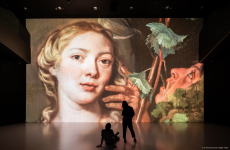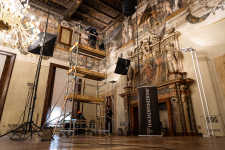Along the walls of the Scrovegni Chapel and under its ceiling of azure and golden stars, the cycle of frescoes depicts the stories of the life of the Virgin Mary, the stories of the life of Jesus and an extraordinary view of the Last Judgement.
Giotto worked on the Scrovegni Chapel between 1303 and 1305, when the chapel was first consecrated and when Enrico degli Scrovegni commissioned Giotto to paint the cycle of frescoes. Giotto was well established as a painter by then and he had many assistants to help produce the rich iconography of the Chapel. The narration begins with the Expulsion of Joachim from the Temple and continues in a clockwise spiral. This small chapel in Padua is recognized throughout the world as one of the greatest masterpieces of western art and is an essential starting point for all of modern painting.
Haltadefinizione has made an ultra-high definition digital photographic scan of the entire cycle, with the permission of the Municipality of Padua, which owns the monument. To cover the work’s entire surface area of more than 700 square meters (7535 square feet), the photographic process included a total of 14,000 images and a year for the completion of image processing. Now we can navigate through these enchanting frescoes using a 360-degree multimedia online viewer, which offers a new perspective on Giotto’s work. With this sophisticated new photographic technoogy we can zoom all the way into the surface of the painting without ever losing focus and resolution.
The visitors enter the virtual Chapel where they can select a fresco to examine in ultra-high definition. This allows for close viewing, despite the work’s location high up a wall or beyond security barriers. This way, anyone can view the details of a unique masterwork very closely, from the comfort of home. Viewers can see the work more closely than is possible with the naked eye. One of the great potential virtues of ultra-high definition images is the opportunity to allow close viewing of works that are otherwise very hard to get to. Such is the case of this magnificent cycle of frescoes, which reach heights of 13 meters (almost 43 feet).
“The Scrovegni Chapel is an important new achievement for Haltadefinizione and it fits into our broader project of development of accessibility to the cultural heritage of Italy, which began in 2007 with Leonardo da Vinci’s Last Supper,” says Luca Ponzio, founder of Haltadefinizione. “In 2019 we signed an agreement with the Italian Ministry of Cultural Heritage to enhance and promote the collections that belong to the Italian government. That has led to important collaborations with Gallery of the Academy of Florence, the Pinacoteca di Brera of Milan, and the National Galleries of Ancient Art in Rome, with the scope of enhancing access and monitoring the conservation status of the works. We are very proud to add this masterwork of Giotto to our database of over 600 works.”
Digital technology in the arts and its application to cultural affairs is a hot topic, and many Italian museums in the last few years have taken the opportunity to work with Haltadefinizione to realize their plans. Digital technology can do a lot for a museum, including restoration and monitoring the conservation status of works, enhancing public access, publicity and teaching. Given the importance of the subject, the Ministry of Cultural Heritage has recently published a digitalization plan for the entire cultural heritage, with the purpose of coordinating activity to serve the public and to ensure the effectiveness of policies to enhance the cultural heritage online.
This is confirmation of the fundamental strategic importance of digital technology to the arts.



